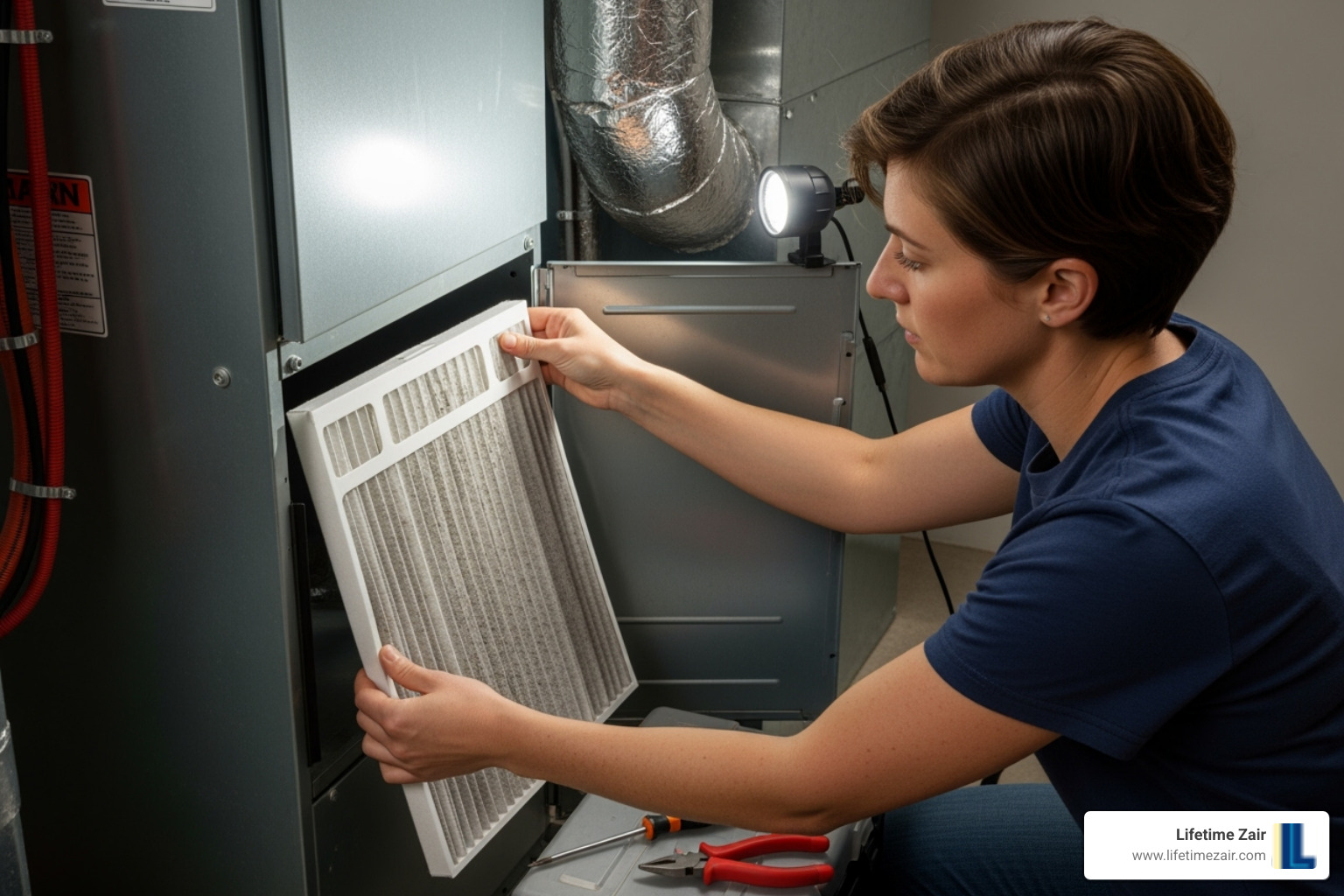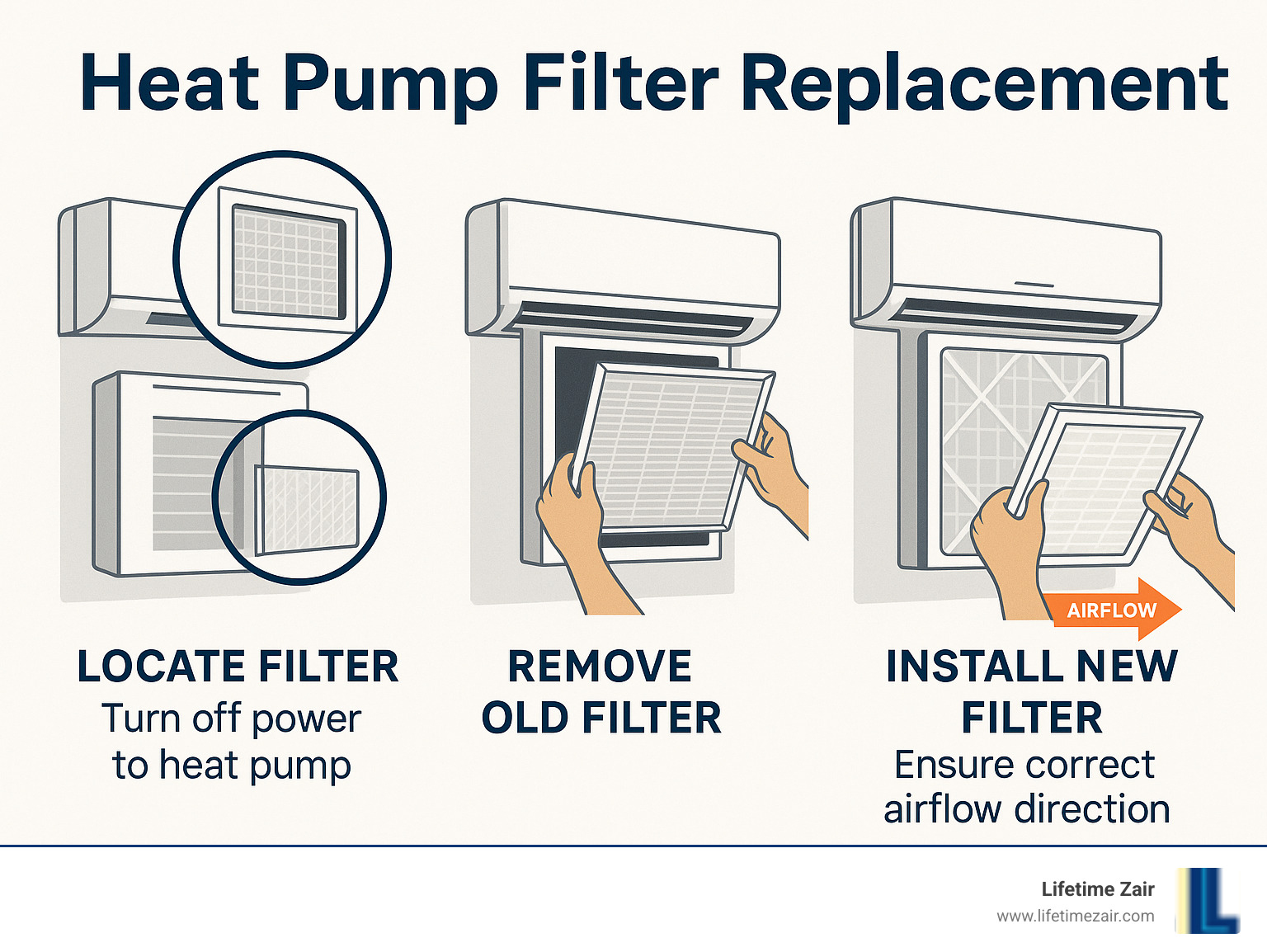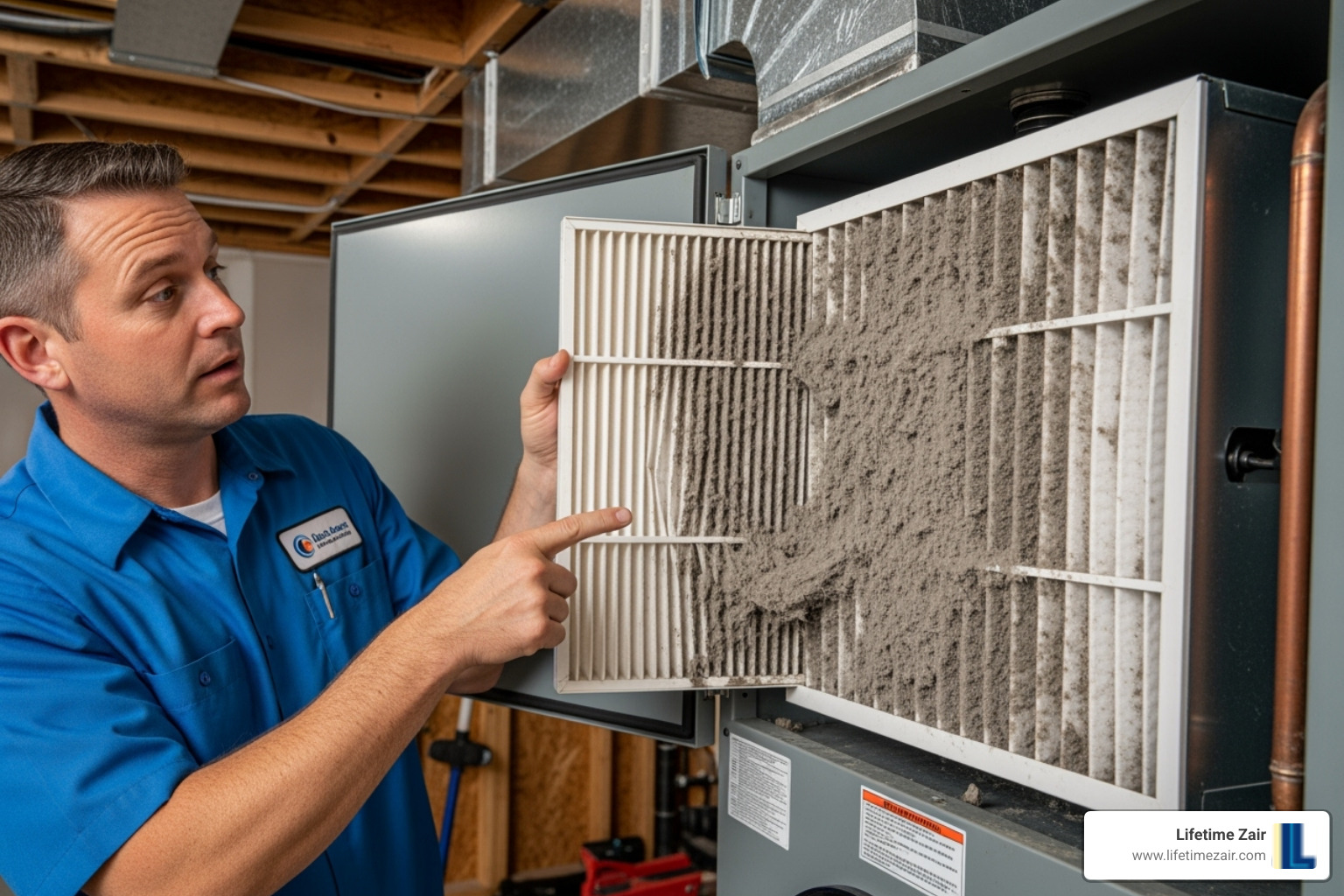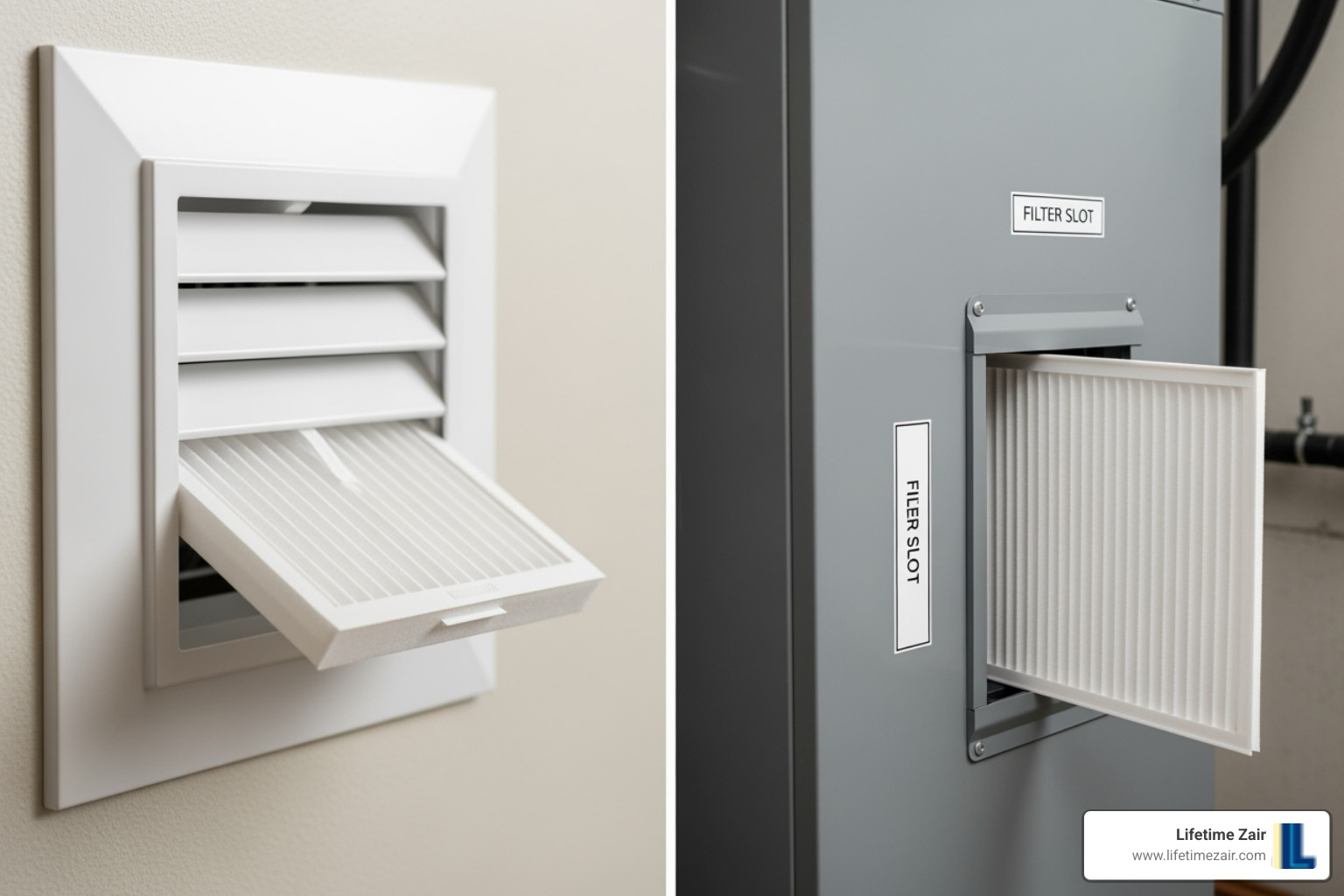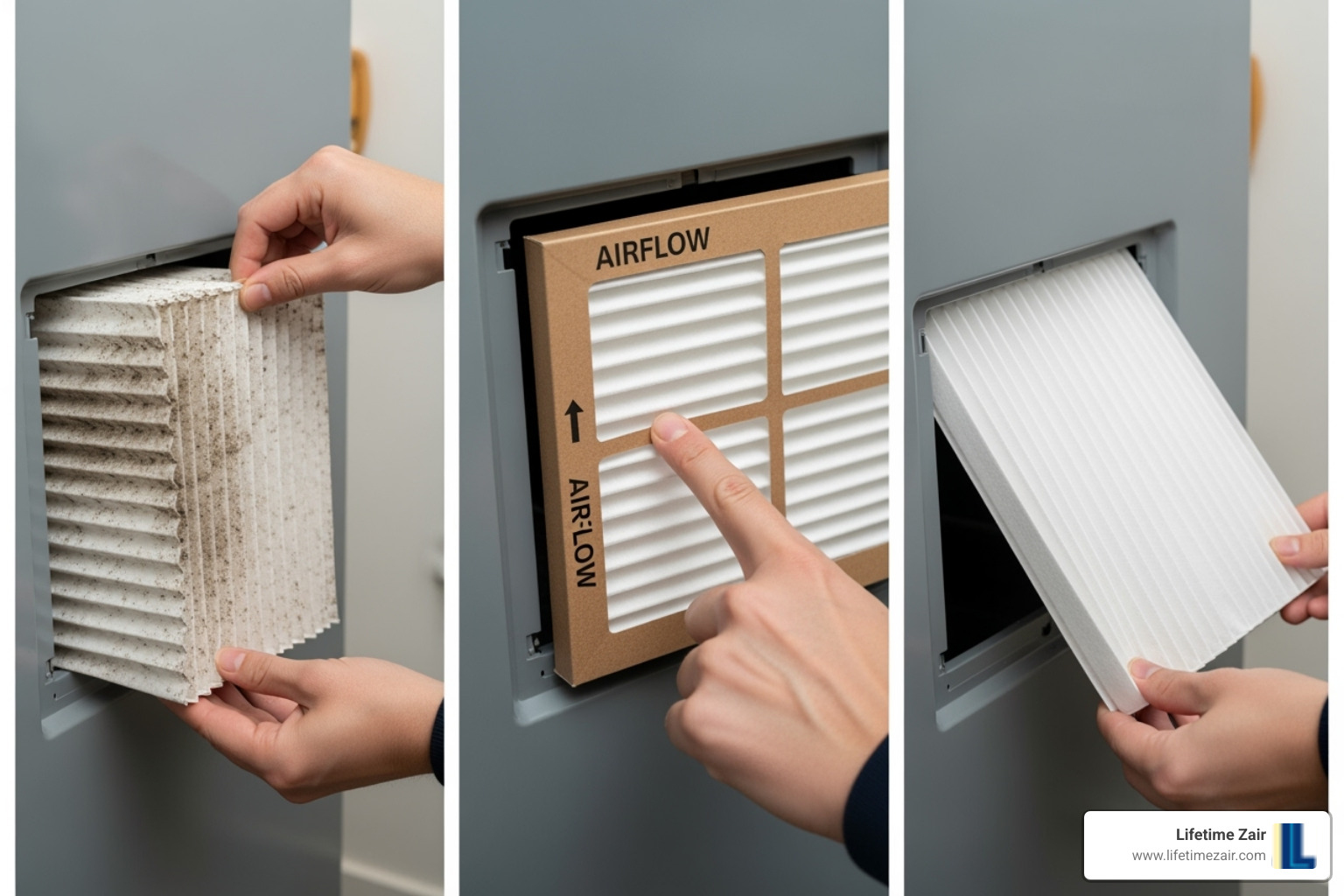Why Heat Pump Filter Replacement Matters for Your Home
Heat pump filter replacement is a crucial DIY maintenance task for system efficiency and clean indoor air. Here’s what you need to know:
Quick Filter Replacement Guide:
- Turn off power to your heat pump at the thermostat or breaker
- Locate the filter – usually in the return air vent or air handler unit
- Remove old filter and note the airflow arrow direction
- Install new filter with arrow pointing toward the air handler
- Replace every 1-3 months depending on usage and home conditions
Your heat pump’s air filter is the guardian of your HVAC system. Since indoor air pollutants can be two to five times higher than outdoor levels, your filter’s job is critical for your family’s health.
A clean filter protects expensive components from damage and ensures proper airflow. When a filter gets clogged, your heat pump works harder, which can increase energy bills by up to 20% and lead to costly breakdowns.
The good news is that filter replacement is simple and takes just a few minutes. Filters are usually in accessible spots like return air vents or the air handler unit, making this an easy DIY task.
Regular changes also improve your home’s air quality by trapping allergens and dust, which can significantly reduce symptoms for families with allergies or pets.
Why Regular Filter Changes are Crucial for Your Heat Pump
Skipping heat pump filter replacement is like forcing your system to breathe through a dusty sock. When your filter gets clogged with dust and pet hair, it creates a bottleneck. Air can’t flow freely, forcing your heat pump to work much harder to move air through your home.
Restricted airflow is the root of many heat pump problems. Without steady air circulation, your system can’t transfer heat effectively, leading to uneven temperatures. This struggle quickly appears on your energy bill. The U.S. Department of Energy found that dirty filters can increase your energy consumption by 15% or more.
System strain from dirty filters also causes premature wear on parts like the blower motor. Poor airflow can even cause your evaporator coils to freeze when not enough warm air moves over them, leading to system failure and potential water damage.
Finally, your family’s health suffers when a clogged filter recirculates allergens and dust instead of trapping them. This can worsen symptoms for anyone in your family who deals with allergies or asthma.
The good news? Regular heat pump filter replacement prevents all these headaches. It’s one of the simplest ways to keep your system happy and your family comfortable.
If you’re already dealing with heat pump problems, don’t wait for things to get worse. Our team has helped countless homeowners with solving heat pump issues in Plano, and we’re always ready to help. When you need professional assistance, just call us for heat pump repair.
Choosing the Right Filter for Your System
Choosing a filter can feel overwhelming, but the “right” one for your heat pump filter replacement matches your system’s needs and your lifestyle, not the price tag.
Disposable filters are the most popular choice. Fiberglass filters are a budget-friendly option that catches large particles like dust and lint. Pleated filters, made from cotton or polyester, have more surface area to trap smaller particles like pet dander and pollen, offering a great balance of performance and price. Electrostatic filters use static electricity to attract microscopic particles.
Reusable filters are a washable, eco-friendly option with a higher initial cost, but they can last for years with regular cleaning, which involves rinsing and completely drying them before reinsertion.
| Feature | Disposable Filters | Reusable Filters |
|---|---|---|
| Initial Cost | Lower | Higher |
| Maintenance | Simple replacement, no cleaning | Regular cleaning required |
| Filtration | Varies widely (basic to high-efficiency pleated) | Generally good, but can vary by design |
| Lifespan | 1-3 months (or less) | 2-3 years (or more) with proper care |
| Environmental Impact | More waste | Less waste |
Understanding the MERV Rating
MERV (Minimum Efficiency Reporting Value) is a rating from 1 to 16 that indicates how well a filter traps airborne particles—the higher the number, the better the filtration. You can learn more from the EPA’s guide on What is a MERV rating?.
For most homes, a MERV 8-13 filter is ideal. It captures common particles like dust, pollen, and pet dander without overly restricting airflow. A filter with too high a MERV rating can strain your system.
Finding the Correct Size
Getting the right size is crucial. Check the dimensions printed on your current filter’s frame, which will look something like “20x25x1”. These are nominal sizes, which are slightly larger than the filter’s actual dimensions to ensure an easy fit. If the size is missing or seems incorrect, measure the filter slot and round up to the nearest inch to find the nominal size.
An incorrectly sized filter will leave gaps, allowing dirty air to bypass it and harm your system and air quality.
Choosing the right filter makes a huge difference in how efficiently your heat pump runs and how clean your air stays. For more insights on keeping your system running at peak performance, check out our tips on Energy Saving Heat Pumps in Lewisville.
Your Step-by-Step Guide to Heat Pump Filter Replacement
Replacing your heat pump’s air filter is a straightforward DIY task that takes less than 15 minutes. Here’s our simple guide.
Tools You’ll Need:
- Your new, correctly sized replacement filter
- Gloves (optional, but recommended for handling dirty filters)
- A marker (to write the date on the new filter)
- A screwdriver (optional, only if your filter compartment is secured with screws)
- A vacuum with a hose attachment (for cleaning the housing)
Step 1: Turn Off the Power
Safety first! Always turn off the power to your heat pump before starting. You can do this by setting the thermostat to “Off,” turning off the dedicated circuit breaker, or using the power switch on or near the indoor unit. For complete safety, we recommend using the circuit breaker.
Step 2: Locate the Air Filter
Your filter is usually in one of two places:
- At the Indoor Air Handler: Most commonly, the filter is in a slot on the air handler, located in a closet, basement, or attic. The slot is often near where the return air duct connects. For help understanding your system’s layout, especially with Heat Pump Systems McKinney, our team can assist.
- In a Return Air Vent: Sometimes, the filter is behind a large return air vent grille in a wall or ceiling.
If you’re unsure, your owner’s manual will show the exact location.
Step 3: Perform the Heat Pump Filter Replacement
With the power off, you’re ready for the actual heat pump filter replacement:
- Access the Filter: Open the cover plate or grille, which may require unlatching a clip or removing screws.
- Remove the Old Filter: Carefully slide out the dirty filter. Gloves are recommended to keep your hands clean.
- Note the Airflow Arrow: The old filter has an arrow indicating airflow direction. Your new filter must be installed with the arrow pointing the same way—towards the air handler.
- Clean the Housing (Optional but Recommended): Use a vacuum to clean any dust from inside the filter compartment.
- Insert the New Filter: Slide the new filter in, ensuring the airflow arrow points toward the air handler. It should fit smoothly.
- Secure the Cover: Replace the cover or grille, ensuring it’s sealed tightly.
- Restart Your System: Turn the power back on and set your thermostat to your desired mode.
How Often Should You Change Your Heat Pump Filter?
The honest answer to how often you should change your filter is: it depends. The general rule is every 1-3 months, but several factors can change that schedule.
For standard one-inch filters, plan on monthly changes during peak heating and cooling seasons, but never go longer than three months. Thicker four- or five-inch filters have more surface area and can often last longer.
Your home’s specific conditions are the biggest factor.
- Pets: Pet owners often need to change filters every 30 days due to dander and fur.
- Allergies or Asthma: For these households, changing filters every 2-4 weeks during high-pollen seasons is essential for better air quality.
- Other Factors: Homes with smokers, those in dusty areas, or with high system usage also require more frequent changes.
Signs it’s time for a heat pump filter replacement
Your system will tell you when it needs a new filter. Look for these signs:
- Visible Dirt: The most obvious sign. If the filter is gray or you can’t see light through it, it’s time.
- Increased Dust: More dust settling on furniture is a clear indicator.
- Reduced Airflow: If the air coming from your vents feels weaker, check the filter.
- Higher Energy Bills: A sudden spike in utility costs can mean your system is working harder to push air through a clog.
- Musty Odors: Unpleasant smells can indicate a filter is harboring mold or mildew. For other strange sounds, see our guide on Here’s Why Your Heat Pump Makes Loud Noises.
Many smart thermostats will also notify you when it’s time for a change.
Creating a Replacement Schedule
To stay on track, set recurring reminders on your phone or calendar. A great tip is to write the installation date on the new filter’s frame. You can also use filter subscription services that deliver replacements to your door automatically.
Frequently Asked Questions about Heat Pump Filters
Here are answers to the most common questions we hear from homeowners.
Can I run my heat pump without a filter?
The answer is a firm no! Running your system without a filter allows dust and debris to enter your system’s sensitive components, which can lead to:
- A dirty evaporator coil, reducing efficiency and potentially freezing over.
- A damaged blower motor from overheating.
- Poor indoor air quality as allergens circulate freely.
- Voiding your manufacturer’s warranty.
Never run your system without a filter. It’s better to turn it off until you can get a replacement.
What happens if I install the filter backward?
This common mistake impacts performance. The airflow arrow on the filter’s frame must always point toward the air handler. Installing it backward reduces the filter’s effectiveness and can cause restricted airflow if the material buckles, leading to system strain.
Do I need a professional for this task?
For basic heat pump filter replacement, you generally don’t need a professional. However, you should call a pro if:
- The filter is in a hard-to-reach location.
- You have a whole-house air purification system with specialized filters.
- You are unsure about the correct filter size or type.
- You’ve replaced the filter but still have problems like poor airflow or high bills.
While you can change filters yourself, we always recommend annual professional maintenance to keep your entire system in top shape. For comprehensive care, including Heat Pump Installation by Our Experts Plano, our team is ready to assist.
Conclusion: Keep Your System Running Smoothly
Regular heat pump filter replacement is a simple task with significant benefits for your home. You’re not just changing a filter; you’re protecting your investment and your family’s comfort.
Consistent changes lead to better air quality, lower energy costs, and a longer system life by protecting vital components from dirt and strain. This helps you avoid unexpected and costly repairs.
The best part is that filter replacement is an easy DIY task you can do in minutes. It’s a satisfying way to take care of your home.
At Lifetime Zair, we believe in empowering homeowners. While you can handle filter changes, our team is always ready to provide professional expertise, from maintenance plans to complex repairs. Whether you’re in Plano or elsewhere in our service area, we’re committed to keeping your heat pump running smoothly so you can enjoy your home in comfort.
For comprehensive care of your Heat Pump Systems in Dallas TX, contact our experts today!
